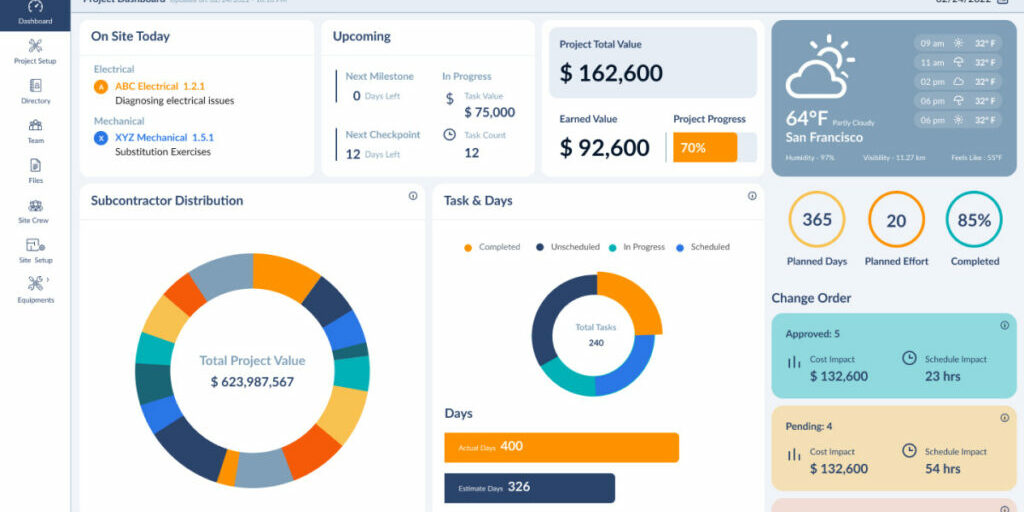3 Surprising Construction KPIs Many Contractors Overlook

Contractors rely on many different construction KPIs (Key Performance Indicators) to measure project and business success.
KPI categories include financial performance, productivity, quality control, schedule performance, and customer satisfaction.
But not all construction KPIs are directly related to short-term profit and productivity. Instead, some KPIs can impact a construction company’s future and the project owner’s.
Here are three valuable KPIs that many contractors overlook:
Here’s what we cover:
1. Value-Added Work (%) as a KPI:
Value-added work refers to construction activities and business processes that directly contribute to the project’s objectives and provide the client or end-user value.
Measure value-added work by determining the ratio between an asset’s lifetime value and the whole life cost of that asset, including development, construction, management, and ongoing maintenance costs.
Here’s an overview of how to capture and analyze value-added work as a KPI and why it’s essential.
Why is value-added work an important construction KPI?
Working with the project owner, and design team, contractors can contribute data related to the tasks and activities they contribute that add value to the project.
These tasks may vary depending on the project’s objectives, scope, and client requirements, but these contributions are essential.
By capturing and reporting value-adding work, contractors give the owner a better understanding of the lifetime value of the constructed asset. This information helps owners make better business decisions, now and in the future.
Value-added work can also be a powerful KPI that allows contractors and owners to pinpoint problematic activity and make decisions that will positively impact the asset’s performance and value over time.
How do I track value-adding activities?
To track the costs associated with value-adding tasks, contractors can use a cost accounting system that captures costs at the task level.
Here are the steps to follow to track the costs associated with value-adding tasks:
- Define value-adding tasks:
- As mentioned, contractors must define what tasks constitute value-adding work for each project.
- Identify and document all project tasks so each stakeholder can understand them and access their specifications and requirements.
- Assign costs to tasks:
- Assign costs to each value-adding task, including all direct and indirect costs associated with the task, such as labor, equipment, materials, and overhead costs.
- Work Breakdown Structures (WBS) provide the perfect opportunity to identify value-adding tasks and connect them to the production schedule for accurate reporting.
- Use a cost accounting system:
- Accurate cost accounting begins at the task level.
- Your accounting system should capture costs for each value-adding task and assign them to the appropriate cost category.
- Cost accounting is another excellent use of Linarc’s Work Breakdown Structure (WBS) system.
Reports and analysis:
- Don’t wait to run your reports and analysis.
- It’s vital to compare actual and budgeted costs and identify cost overruns or savings opportunities as the project progresses.
- Contractors should report on the costs associated with value-adding tasks to their clients and stakeholders continuously.
- Cost reports must highlight areas of concern and improvement opportunities and provide actionable insights to implement corrections in real-time.
By tracking costs associated with value-adding tasks, contractors can identify areas where they can optimize their operations and increase the value they provide to their clients.
They can also use this metric to demonstrate their value as professionals and differentiate themselves from competitors in the industry.
2. Measuring rework as a valuable construction KPI
Rework is any field activity done more than once, incorrect work installed due to design errors, construction defects, or work that fails to meet quality standards and requires repair.
Rework can result in significant cost overruns, delays, and quality issues. And safety is always a concern.
Did you know that rework causes more injuries than any other project activity?
It’s true.
And frequent rework can also affect morale and productivity, making it an important KPI for construction contractors to track.
How to measure rework as a KPI?
Collect data on the number of rework instances and associated costs.
Rework measurements include tracking the hours spent, materials used, wasted or destroyed, and downtime resulting from the rework.
Measure the impact of rework on project quality and safety by tracking the number of injuries and safety incidents related to rework and associated activities.
By analyzing this data, contractors can identify the root causes of rework, identify patterns and trends, and develop strategies to reduce rework, protect their employees, minimize their corporate risk exposure, and improve their overall business performance.
3. ESG as a valuable construction KPI
ESG stands for Environmental, Social, and Governance; the three key areas companies consider when evaluating their sustainability and ethical practices.
In the construction industry, ESG refers to the impact of construction projects on the environment, the social impact of construction activities on local communities, and construction contractors’ governance and ethical standards.
ESG is becoming increasingly important in the construction industry as companies seek to reduce their carbon footprint, promote social responsibility, and improve their corporate governance practices.
Here are some ways that contractors can measure ESG as a KPI:
- Environmental Impact: Contractors can measure their environmental impact by tracking metrics such as energy consumption, water usage, waste generation, and greenhouse gas emissions. They can use tools like Life Cycle Assessments (LCA) to evaluate their construction activities’ environmental impact and identify improvement area
- Social Impact: Contractors can measure their social impact by tracking metrics such as community engagement, local hiring, worker safety, and diversity and inclusion. They can use tools like Social Impact Assessments (SIA) to evaluate the social impact of their construction activities and develop strategies to mitigate any negative impact.
- Governance and Ethics: Contractors can measure their governance and ethics by tracking transparency, accountability, and compliance with legal and ethical standards. They can use tools like the Global Reporting Initiative (GRI) to report on their governance and ethical practices and demonstrate their commitment to sustainability.
By measuring ESG as a KPI, construction contractors can assess their sustainability and ethical practices, identify areas for improvement, and make data-driven decisions to optimize their operations and achieve their business objectives.
Measuring ESG KPIs can help contractors improve their practices, enhance their reputation, and attract new business. And improving in these three areas contributes to a more sustainable and equitable planet and construction industry.
Don’t overlook these 3 valuable construction KPIs
Value-added work, rework, and ESG (environmental, social, and governance) are increasingly important KPIs for construction companies.
Contractors can track these metrics by collecting data with a comprehensive, integrated project management system like Linarc.
Linarc simplifies data capture, reporting, work tracking, and root cause analytics so construction contractors can develop strategies to optimize their processes while mitigating project risks.
By tracking these 3 little-known KPIs, contractors can optimize their operations, increase the value they provide to their clients, and differentiate themselves from competitors in the industry.
Increase project value with software built for safety, quality, and performance
Get a free, custom demonstration of the Linarc construction management system today.
Linarc is a cloud-based project management system built solely for collaborative, data-driven construction management.
- Seamless collaboration
- Easy file sharing
- Common communication platform
- Real-time updates on project progress
- …and so much more
Connect with a Linarc representative and see what the power of software technology can do to improve the productivity of your operation.
Connect – Build – Thrive with Linarc construction management software





